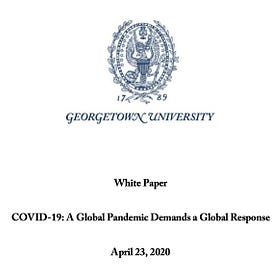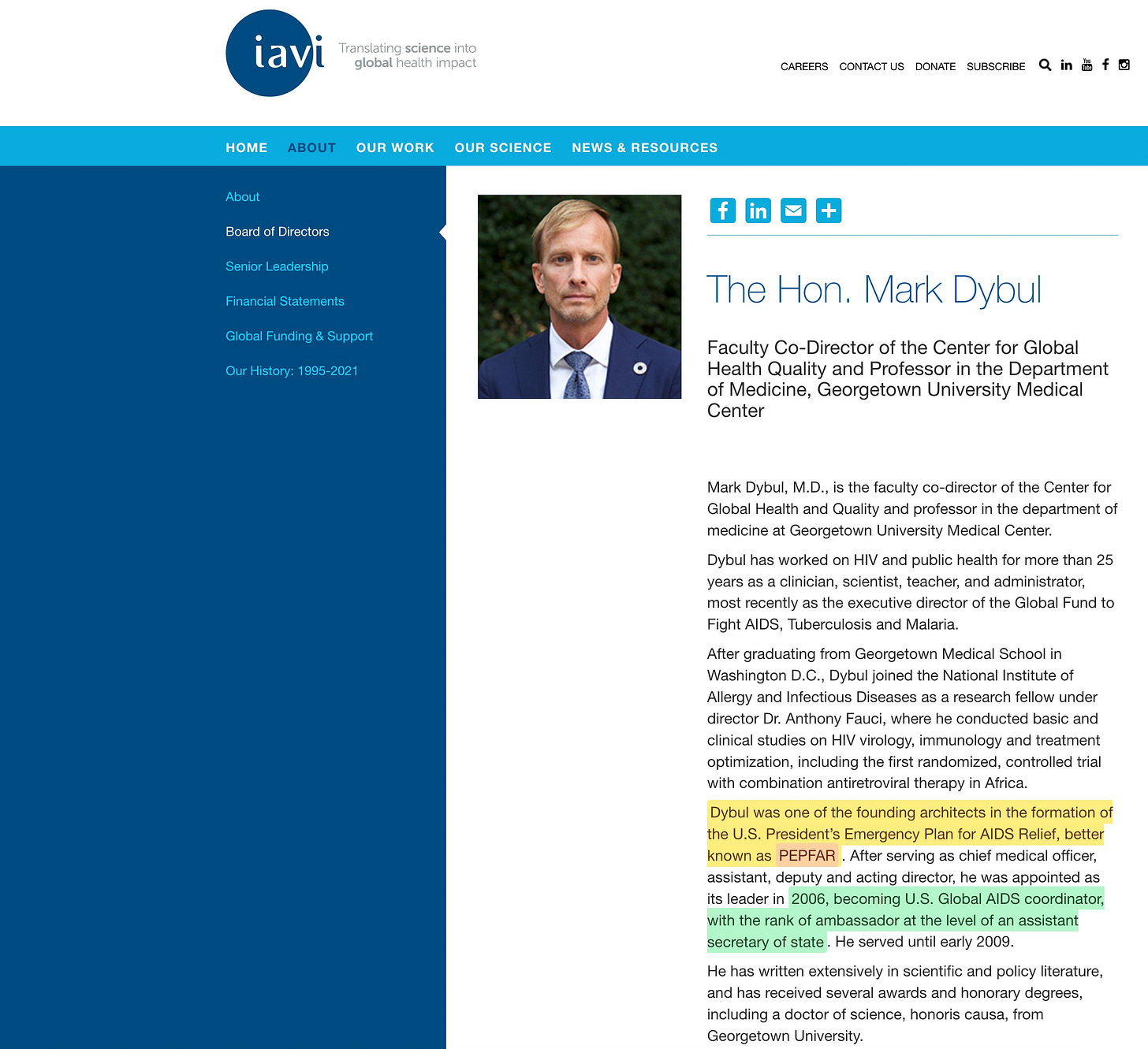PEPFAR
The ‘President’s Emergency Plan for AIDS Relief‘ - or ‘PEPFAR’ - was first mentioned by George W Bush in his State of the Union address in 2003. And let’s just cut to the chase, it’s not really about AIDS.
-
While the address is light on detail, the '2005 ‘PEPFAR - First Annual Report to Congress’ is of somewhat more use, should you wish to discover more in this regard.
The introductory pages are the typical sell-side empty rhetoric coupled with promises which will never materialise.
The executive summary is somewhat more detailed. It’s the ‘largest health initiative in history’ (supposedly) ‘dealing with a single disease’ (supposedly), and it’s a response to the ‘global HIV/AIDS pandemic’ (supposedly).
Glad we cleared that up. I suppose 1 out of 3 isn’t awful, but it would have been better had all 3 of 3 been correct.
But you won’t have to read on for long before something sticks out. Because on the same page, it’s revealed that the ‘new approach’ is ‘integrated’, that it involves ‘international research’, and that money involved also was used for purposes of ‘other HIV/AIDS efforts’. Already now, the questions are piling up.
It also states that it’ll work to deliver safe and effective vaccines, and that the response outlines a ‘unified US government effort’, following on from the 2002 initiative - ‘International Mother and Child HIV Prevention Initiative‘, which for the record is about delivering drugs to pregnant women, and improve supply (delivery) in this regard. Ie, the kind of ‘saving lives’ big pharma become entirely enthusiastic about.
And before we move on from page 13, we have the following two snippets -
‘A guiding principle of the President’s Emergency Plan is to build local and host-nation capacity so that national programs can achieve results, monitor and evaluate their activities, and sustain their programs for the long term‘, and ‘development of new public and private network systems‘.
If you’ve read my other articles, you should know where this is heading. Global surveillance.
It’s at this stage I will drag in specifically this article; you will soon realise why - and not just because their system was supposedly engineered to deal with a global AIDS crisis. No, that’s just another coincidence I fear.
The Georgetownian Dystopia
On the 23rd of April, 2020, a whitepaper hit, which by and large has gone completely ignored. It shouldn’t, because it’s one of the worst, and most dystopian papers released during the Scamdemic. It highlights a different side to the alleged covid-19 pandemic, a side which is rarely - if ever - covered in a reasonable way by the MSM. And it’s about surve…
-
‘Other important components of building local capacity include surveillance, reporting, evaluation, and other strategic information needs’
It carries on -
‘In April 2004 in Washington, D.C., OGAC cosponsored the UNAIDS initiated “Three Ones” agreement for cooperation among donors in support of one national strategy, one national coordinating mechanism, and one monitoring and evaluation system in each host country‘.
One strategy. One coordinator. One monitoring system. What this is a call for is a centralised approach. Centralised surveillance.
But it doesn’t just stop at borders - ‘Recognizing that HIV/AIDS does not respect borders, the Emergency Plan incorporates bilateral programs‘ - that’s correct. After the national approach comes the regional, though this here strictly speaking is just a call for neighbourly cooperation. But with 54 nations in Africa, you’ll have a call for a regional authority in no time at all.
And finally - ‘The Emergency Plan also coordinates programs with UNAIDS, the World Health Organization, the United Nations Children’s Fund, the World Bank, and others‘. It even has a picture of Ambassador Tobias shaking hands with the executive director of UNAIDS, who just happens to be a co-author of the Georgetown whitepaper on global surveillance which I linked above — Peter Piot.
Such coincidences.
-
Now, most of the document is waffle. Wild claims of saving 17 brazilion lives, coupled with some absurd economic estimates, so we’ll instead skip to page 99 and the disinteresting chapter 9; ‘IMPROVING ACCOUNTABILITY AND PROGRAMMING‘. It’s the second to final chapter, and the title is bland and boring… in other words - it’s a perfect spot to bury the real story.
And it starts off with ‘collecting and analysing HIV/AIDS data’, though supposedly, this is for ‘program accountability and improvement in the developing world’. They worked very hard on that sentence, ensuring it gave up the least amount of information.
‘Tracking patients and maintaining records’ gives somewhat more of a clue, but which records? It carries on - ‘the Emergency Plan has begun implementation of key strategic information systems identified in the U.S. Five-Year Global HIV/AIDS Strategy. Such strategies include the improvement of surveillance activities‘.
So it’s about surveillance for sure, and ‘In addition, the Office of the U.S. Global AIDS Coordinator (OGAC) has engaged in a number of activities to build country capacity for strategic information and to enhance coordination and cooperation across U.S. Government agencies and external donor organizations, such as UNAIDS, WHO, and the Global Fund to Fight AIDS, Tuberculosis and Malaria‘.
Right, so we have surveillance, and we have cooperation with the WHO, and others. We’re also served ‘Enhanced surveillance efforts‘, ‘complementary data collection‘ and ‘improving the tracking of TB cases through an electronic TB register‘ — so we now have ‘enhanced surveillance with complementary data collection’ which prompts a few questions of its own, and we have an effort in regards to databases… and tuberculosis.
Tuberculosis? This document quite literally started off by claiming that the PEPFAR program was a single-disease initiative.
The document continues - ‘central reporting process‘, and ‘In a number of countries, the Emergency Plan has organized monitoring and evaluation coordinating committees to ensure coordination of the planning and implementation of country HIV reporting systems with existing health information efforts‘.
So now we’ve merged the alleged single-disease initiative with generic ‘existing health information efforts’ in a coordinated (centralised) fashion.
The section on ‘Health Management Information Systems‘ only digs the hole even deeper - ‘collection of core indicator data’, ‘collect client-level and clinical service information‘, and ‘collect facility-, district-, and country-level information‘ in ‘country-level management information systems‘.
Now, call me a cynic, but I start to suspect that this really isn’t about AIDS at all. Especially as it continues — ‘These integrate separate HIV information systems (including patient management, laboratory services, logistics management, program indicators, and HIV facility-based management information systems) into broader regional or national health information systems‘.
‘In Ethiopia, for example, Emergency Plan funding is facilitating the adoption of a national monitoring and evaluation plan and framework in site-level database systems for prevention of motherto-child HIV transmission, TB, antiretroviral treatment, and counseling and testing, and is also expanding public health information systems to all Ministry of Health offices’
By now, the ‘AIDS initiative’ has come to cover all health information, to which the local Ministry of Health also has access.
This is mission creep, driving a Ferrari on a German motorway.
On page 101, the ‘AIDS initiative‘ even loops in geographical information systems activities, and on page 102, the document details the joint US planning, the merger of surveillance systems spanning the DoD, the CDC, USAID and so forth.
Data should furthermore be ‘harmonised’ (compatible data formats), and the initiative should partner up with the likes of the WHO and World Bank.
And should there be any doubt, the next section is suitably titled ‘Integrated coordination‘, and drags in the likes of the WHO, UNAIDS, and the US, the aim being internationally compatible systems. But breathe a sigh of relief, because the ‘donors are working to come up with better systems to collect high-quality data’.
Just take that in. What it states is that the likes of Gates has had access to a growing amount of global health information for at least a couple of decades by now. Your records, which should be utterly private.
Finally, ‘sharing of common data’ goes without saying, and ‘discussions are also under way among US agencies to explore harmonising their existing HIV reporting systems in other nations where the Emergency Plan is at work’. They worked on integrating systems and data at this stage, already.
-
And in 2006, a data bulletin was released, outlining additional information to be added in order to ‘strengthen the surveillance systems’… including drug resistance.
I have found a number of other, similar calls, but rather than waste time on these, let’s see what else we can find of interesting and entirely coincidental stories, connected to PEPFAR. First, we have Deborah Birx becoming CEO of Armata Pharma only recently. She formerly served as the ‘U.S. Global AIDS Coordinator where she oversaw the President's Emergency Plan for AIDS Relief (PEPFAR) at the CDC and as the Director of the U.S. Military HIV Research Program (USMHRP)’.
Then we have the matter of the founding architect. Mark Dubyl. Who - entirely by coincidence - co-authored the Georgetown global surveillance whitepaper with Peter Piot in April, 2020.
No, really - he did.
Then we have this peach of a report.
There are many things I could comment on in this report, but I will focus on just a single one. PEPFAR is about gathering data. Global data. Data which comes via surveillance. Global surveillance.
HIV is just the vehicle allowing it access.
And before wrapping up, how about this one from 2010?
-
But what about developments and state of implementation since? It’s been a couple of decades by now, after all. Here’s a MMWR from 2019. PEPFAR supported countries at that time counted 39.
And does PEPFAR use the ‘so-called One Health approach’? You betcha! August 2023, and in the BMJ. And it also mixes in…
The Global Health Security Agenda. But of course. In fact, this Department of State press release doesn’t just stop with the GHSA, it also explicitly drags in the WHO, IHR, One Health, and… the Pandemic Accord.
And it was penned in September, 2023. No more than a month ago.


















If there ever was an "overpopulation problem", they could just let "infectious" diseases run through the population. No one would blame allopathic medicine or big pharma for the failure of research or treatment. As no one does today. Call it "fate".
But If there are no "infectious diseases", what else can psychopaths do who are obsessed with controlling the people and the earth's ressources, especially in earth rich countries like Africa where most people live off any kind of grid? They invent the idea of plagues, drive people into a grid of control via money and incentives around "infectious diseases", make an inventory of the african population and try hard to manage all the ressources, including the human "material" for labor purposes. Win win. They use them for cheap labor, don't let them participate, control their numbers and plunder the country all in one by "providing and facilitating" healtcare.